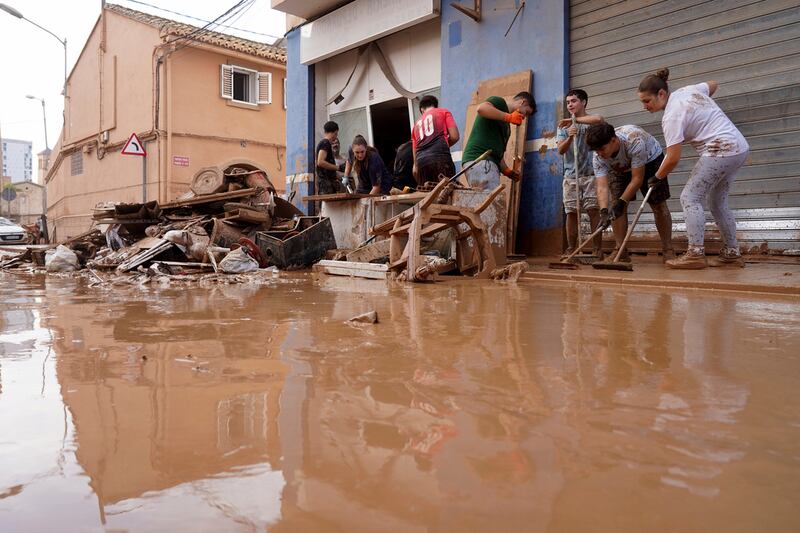MADRID (AP) — In a matter of minutes, the flash floods caused by the intense downpours on Tuesday in eastern Spain swept away everything in their path. With no time to react, people were trapped in vehicles, homes, and businesses. Many died and thousands of lives were shattered.
PUBLICIDAD
Three days later, authorities have recovered 205 bodies—202 in the eastern region of Valencia, two in Castilla La Mancha, and one in Andalucia—and are searching for an undetermined number of missing persons following the worst autumn rain episode in recent history in Spain.
PUBLICIDAD
In response to the warnings of more rainfall in the coming days, people have started to clean up the thick layer of mud covering homes and streets filled with debris, while facing power and water outages and shortages of some basic products. Inside some vehicles that the water dragged into piles or crashed against buildings, there are still fatalities waiting to be identified.
Here are some facts about the tragedy:
What happened?
The concentrated storm train in the basins of the Magro and Turia rivers and in the Poyo ravine - where towns like Turís received more than 630 liters/square meter in 24 hours - caused a wall of water that overflowed the riverbeds, catching some residents off guard as they went about their daily lives. Many were returning home after their workday.
In the blink of an eye, muddy water covered roads, train tracks, and seeped into homes and businesses in towns along the riverbed and in the southern outskirts of Valencia. Drivers, with their vehicles turned into boats, had to take refuge on their roofs, while residents tried to seek shelter in higher areas.
When the authorities sent an alert to cell phones warning the population of the seriousness of the phenomenon and asking them to stay at home, many were on the road, working, or covered in water in low-lying areas or garages, which became deadly traps.

Why do these phenomena occur?
The scientists trying to explain what happened on the Levantine coast see two possible connections to man-made climate change. One is that warmer air retains and then releases more rain. The other is the potential changes in the jet stream—the flow of air over the land that moves weather systems around the planet—which leads to extreme weather events.
Several climatologists and meteorologists argue that the immediate cause of the floods is a storm system of low pressures that detached from an unusually wavy and stagnant jet stream. This system stalled over the region and brought intense downpours. This happens so often that in Spain they are given a specific name, Isolated High-Level Depression, or DANA, according to meteorologists.
And then there is the unusually high temperature of the Mediterranean Sea. In mid-August, it broke its surface record, reaching 28.47 degrees Celsius, said Carola Koenig, from the Flood Risk and Resilience Center at Brunel University in London.
The phenomenon also occurs following the prolonged drought that hit the country in 2022 and 2023. Experts claim that drought and flood cycles are increasing with climate change.
Has something like this happened before?
The Spanish Mediterranean coast is used to autumn storms that can cause floods, but this has been the most severe episode on record. The older residents of Paiporta, the epicenter of the tragedy, claim that the floods on Tuesday were three times worse than those of 1957, which caused at least 81 deaths and was the worst in the history of the tourist region. That flood caused the diversion of the Turia River's course, which has allowed a large part of the city to avoid those floods.
Valencia suffered two more major DANA events in the 1980s, one in 1982 with around thirty deaths, and another five years later that broke precipitation records.
With at least 158 dead, this is also the deadliest natural disaster in the history of Spain, surpassing the flood that devastated a campsite along the Gállego River in Biescas, in the northeastern province of Huesca, and killed 87 people in August 1996.

What has been the government's response?
The management of this crisis, classified as level two on a scale of three by the Valencia government, is in the hands of the regional authorities, who can request assistance from the central government to mobilize resources.
At the request of the Valencian president, Carlos Mazón, from the conservative Popular Party, the central government led by the socialist Prime Minister Pedro Sánchez has deployed an additional 500 soldiers, who joined the 1,200 members of the Military Emergency Unit - the first intervention force of the Army in natural disasters and humanitarian crises - who were already working on the ground.
On Saturday, 500 more people will join the rescue efforts, debris cleaning, and distribution of supplies. Additionally, there are nearly 2,500 Civil Guard agents on the ground - who have carried out 4,500 rescues during the floods - and 1,800 national police officers.
When many of the affected individuals said they felt abandoned by the authorities, a wave of volunteers took to the streets to help. Armed with brooms, shovels, water, and basic food supplies, hundreds of people walked several kilometers on Thursday and Friday to distribute supplies and assist in cleaning the hardest-hit areas.
It is expected that Sánchez's government will approve the declaration of a catastrophic zone on Tuesday, which will allow those affected to quickly access financial aid. Mazón has announced additional financial aid.
The Valencian government had been criticized before for the delay in sending mobile alerts, which arrived at 8 pm on Tuesday, when some towns had already started flooding, more than 12 hours after the Spanish meteorological agency had issued a red alert for rain.
